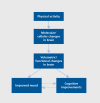Physical activity and brain plasticity in late adulthood
- PMID: 23576893
- PMCID: PMC3622473
- DOI: 10.31887/DCNS.2013.15.1/kerickson
Physical activity and brain plasticity in late adulthood
Abstract
The human brain shrinks with advancing age, but recent research suggests that it is also capable of remarkable plasticity, even in late life. In this review we summarize the research linking greater amounts of physical activity to less cortical atrophy, better brain function, and enhanced cognitive function, and argue that physical activity takes advantage of the brain's natural capacity for plasticity. Further, although the effects of physical activity on the brain are relatively widespread, there is also some specificity, such that prefrontal and hippocampal areas appear to be more influenced than other areas of the brain. The specificity of these effects, we argue, provides a biological basis for understanding the capacity for physical activity to influence neurocognitive and neuropsychiatric disorders such as depression. We conclude that physical activity is a promising intervention that can influence the endogenous pharmacology of the brain to enhance cognitive and emotional function in late adulthood.
Si bien el cerebro humano se reduce a medida que avanza la edad, la investigación reciente sugiere que también es capaz de una extraordinaria plasticidad, incluso hacia el final de la vida. En esta revisión se resume la investigación que relaciona una gran cantidad de actividad física con una menor atrofia cortical, una mejor función cerebral y un refuerzo de la función cognitiva, y se argumenta que la actividad física hace uso de la capacidad natural del cerebro para la plasticidad. Además, aunque los efectos de la actividad física en el cerebro son relativamente generalizados, también hay alguna especificidad, de tal modo que las áreas prefrontal e hipocámpica parecen estar más influenciadas que otras áreas cerebrales. Se argumenta que la especificidad de estos efectos proporciona las bases biológicas para comprender la capacidad de la actividad física para influenciar los trastornos neurocognitivos y neuropsiquiátricos como la depresión. Se concluye que la actividad física es una intervención prometedora que puede influir en la farmacología endógena del cerebro para reforzar las funciones cognitivas y emocionales en la adultez avanzada.
Le cerveau humain se rétracte avec l'âge mais est aussi doté d'une plasticité remarquable, même à un âge avancé comme le montrent des études récentes. Nous résumons dans cet article les données de la recherche associant une activité physique plus importante à une moindre atrophie corticale, à un meilleur fonctionnement cérébral, et à des fonctions cognitives améliorées. Nous discutons du fait que l'activité physique bénéficie de l'aptitude naturelle du cerveau à la plasticité. De plus, bien que les effets d'une activité physique sur le cerveau soient assez généralisés, il existe certains effets specifiques comme ceux sur l'hippocampe et le cortex préfrontal qui semblent plus influencés que les autres aires cérébrales. Nous pensons que ces effets spécifiques fournissent une base biologique à la comprehension de l'influence exercée par l'activité physique sur les troubles neurocognitifs et neuropsychiatriques comme la dépression. Cette activité physique semble donc prometteuse en termes d'action sur la pharmacologie endogène du cerveau pour améliorer les fonctions émotionnelles et cognitives chez les personnes âgées.
Keywords: aging; brain; exercise; neuroplasticity; physical activity; plasticity.
Figures

References
-
- Alzheimer's Association. 2012 Alzheimer's Disease Facts and Figures. Alzheimers Dement. 2012;8:131–168. - PubMed
-
- Blair SN., Kohl HW., Paffenbarger RS., Clark DG., Cooper KH., Gibbons LW. Physical fitness and alll-cause mortality. JAMA. 1995;262:2395–2401. - PubMed
-
- Paffenbarger RS., Wing AL., Hyde RT. Physical activity as an index of heart attack risk in college alumni. Am J Epidemiol. 1978;108:12–18. - PubMed
-
- McTiernan A., Kooperberg C., White E., et al Recreational physical activity and the risk of breast cancer in postmenopausal women: The Women's Health Initiative Cohort Study. JAMA. 2003;290:1331–1336. - PubMed
Publication types
MeSH terms
Grants and funding
LinkOut - more resources
Full Text Sources
